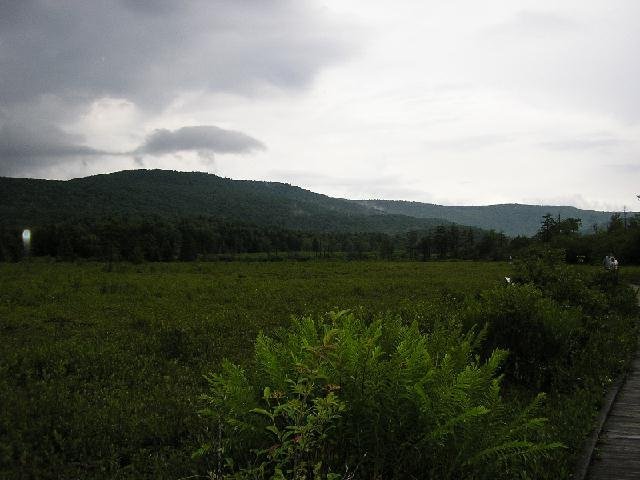Coordinates are to the beginning of the boardwalk. Access is from Route 39/150 take Forest Service Road 102 north approximately one mile. This cache may be wheelchair accessible, allow 30 minutes to complete.
CRANBERRY GLADES BOTANICAL AREA is a 750 acre area consisting of four bogs (locally known as glades), located in the Monongahela National Forest just north of the Cranberry Mountain Nature Center. A 1/2 mile barrier free wooden boardwalk takes you through two of the four glades.
Bogs are distinctive wetlands characterized by spongy peat deposits, acidic waters, and a floor of sphagnum [sfag-nuh m] moss. They are low in oxygen and the nutrients needed for plant growth.
Hydrology of a bog
Bogs receive all or most of their water from precipitation. They are isolated from mineral bearing ground ∓ surface water and often have cold water temperatures. Water does not flow in or out of bogs easily, this causes low oxygen content. The combination of cold water temperature, and lack of oxygen make it difficult for fungi ∓ bacteria to decompose dead plants, thus allowing the formation of peat (dead but not decayed plant material). This slow decomposition of plant material causes the acidic characteristics of a bog .
Despite the high acid content and low nutrients, some plants do thrive in bogs. Cranberries, blueberries, orchids, and cotton grass are just some of the plants that make their home here.
The four main types of bogs.
Valley bog - develops in gently sloping valleys or hollows, a stream may run through the surface.
Raised bog - develops from a lake or flat marshy area as silt or peat fill the lake. Eventually peat builds up until the surface is too flat for ground or surface water to reach the center. This becomes wholly rain-fed. As the bog continues to form peat, eventually a shallow dome develops.
Blanket bog - develops in cool climates with consistently high rainfall. The waterlogged ground provides conditions for the development of bog vegetation. This vegetation forms a layer or 'blanket' over the land. It can include hilltops and slopes.
Quaking bog - occurs in wetter parts of valley and raised bogs. A thin layer (two or so feet) floats on water or very wet peat. Walking on the surface will cause it to move. Large movements may produce visible ripples or make trees sway.
What makes this bog special?
The plant and animal life in Cranberry Glades is similar to that found in the bogs of the north. This life spread south over 10,000 years ago when glaciers covered the northern part of our continent. This is now the southern-most point in North America for these life forms.

YOUR PART IN PROTECTING THE GLADES
Stay On The Boardwalk -- it protects the ground from the impact of thousands of visitors and will keep your feet dry.
Pick Nothing, Take Nothing -- Enjoy the plants ∓ wildlife but leave them undisturbed.
Use The Garbage Cans in the parking lot for your trash, and remember that cigarette butts are litter too.
Pets Must Be On A Leash Or Carried. Be careful that wildlife is not disturbed.
No Bicycles Or Pack Animals.
To log this cache.
Take a picture of yourself and your GPS (or just your GPS) anywhere along the boardwalk. The boardwalk must be visible in the picture. Post this picture with your log. (Optional under the new guidelines.)
Using the link on my profile, Email the answers to the following.
- Through what two glades does the boardwalk pass?.
- What is the approximate length of the longest of these two glades.
- The sign at N38 11.894 W80 16.265 (This is the 3rd sign counterclockwise or the 5th clockwise around the boardwalk.) lists two plants with a unique appetite. Name either plant, include what and how it eats.
Do Not post the answers to the above questions, even if encrypted, or your log will be deleted
This Earthcache devloped by a Bronze Earthcache Master